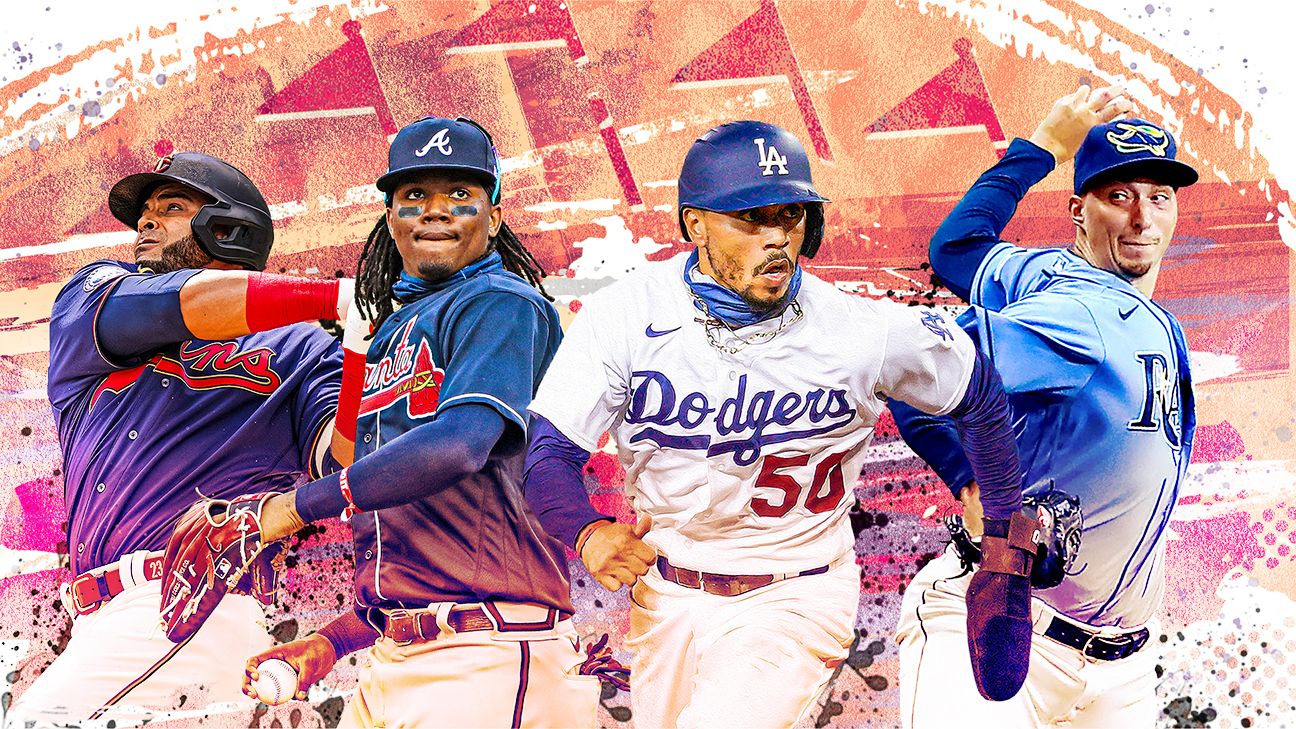It’s time for the MLB playoffs! After a wild sprint to the finish that needed every day of the regular season to determine the seeding, the real fun begins. For the first time, 16 teams will enter the postseason and just a few short days later half of them will be headed home.
Who will rule every round from the wild-card frenzy to the World Series? Will the Los Angeles Dodgers turn the league’s best record into an October coronation? Will the New York Yankees ride a strong finish to postseason glory? Will the Chicago Cubs or Chicago White Sox bring a title to the Windy City? MLB experts Bradford Doolittle, Jeff Passan, Sam Miller and David Schoenfield go deep on everything from the matchups and breakout names you need to know to key stats and very bold predictions for every team. Doolittle has also calculated the odds for every team’s shot at winning it all as well as every potential matchup in each round against any possible opponent.
Watch the 2020 MLB playoffs on ESPN and ABC starting Tuesday at 3 p.m. ET. Don’t have ESPN? Get instant access.
Play: ESPN Playoff Baseball Classic
Jump to each postseason team:
NL: LAD | ATL | CHC | SDP | STL | MIA | CIN | MIL
AL: TBR | OAK | MIN | CLE | NYY | HOU | CHW | TOR

National League
1. Los Angeles Dodgers

43-17 | NL West champs | 29.8% World Series odds
Odds by round
WC: 75.4% vs. Brewers
NLDS: 75.6% vs. Cardinals; 63.3% vs. Padres
NLCS: 88.5% vs. Marlins; 82.7% vs. Reds; 77.8% vs. Cubs; 73.3% vs. Braves
WS: 83.7% vs. Blue Jays; 81.4% vs. Astros; 73.8% vs. A’s; 72.8% vs. Yankees; 72.7% vs. Indians; 70.1% vs. White Sox; 69.4% vs. Rays; 69.3% vs. Twins
How they could go far: If the middle of the bullpen performs at a level that inspires the confidence of Dave Roberts, the Dodgers will be as close to upset-proof as a club can be in a short series. This is partially about Kenley Jansen closing things out, but even more so about Blake Treinen, Jake McGee, Dylan Floro & Co. The bridge guys in the Dodgers’ bullpen are all that stands between a great playoff roster and a perfect playoff roster. Really, though, the variability of a best-of-three format is probably the biggest threat to the Dodgers. — Doolittle
How they could go home before you’re done reading this: There are so many layers and redundancies built into the Dodgers’ roster, it’s hard to point at one key injury or one performance meltdown that, alone, would sink them. Sure, you could make that claim about Jansen, who has had some bad outings, but overall he has converted at a reliable rate. What’s beyond the Dodgers’ control is how the opponent is stepping up, and if they get into a first-round series against a team with a lockdown back of the bullpen, then L.A. runs the risk of a brief run if it gets behind early in a couple of games. In a best-of-three, that’s all it would take to end the season of baseball’s best team. — Doolittle
Most likely October hero: You hope it’s Clayton Kershaw. You want it to be Clayton Kershaw. He has bounced back from a 3.03 ERA in 2019 — great for anyone else, but his highest since his rookie season of 2008 — to dominate in 2020. He’ll be the team’s top starter entering the postseason, not Walker Buehler. But we know Kershaw’s October history: Since 2013, he’s 9-11 over 25 starts (and five relief appearances) with a 4.43 ERA. The Dodgers’ bullpen is deeper than it has been, so Roberts won’t have to fool around with Kershaw in relief. Kershaw also will be subject to a relatively quick hook as a starter, although that’s not new — he hasn’t thrown 100 pitches in any of his past 10 postseason starts. Really, five or six good innings is all that might be asked. May they be filled with zeroes. — Schoenfield
Matchup to watch in Round 1: Really, it’s the postseason demons of not just Kershaw, but of closer Jansen and 2019 MVP Cody Bellinger, more than any individual showdown. Maybe that’s unfair in Jansen’s case, although his two blown saves in the 2018 World Series loomed large in Roberts’ reluctance to use him last year against the Nationals. Still, over the past three postseasons, Jansen has a 1.55 ERA and .122 average allowed over 29 innings. Bellinger, however, has a career line in the playoffs of .178/.234/.326 over 36 games. They need him to produce. — Schoenfield
Their only-in-2020 stat: Dodgers starters have the National League’s lowest ERA this year. They’ve also thrown among the fewest innings, with just 4.7 innings per start — fourth from the bottom. Once upon a time that would have seemed like a contradiction, but these days it can be seen as an explanation, as the Dodgers have protected their starters from overuse, overexposure and the need to pace. Here’s the only-in-2020 stat that most stands out: No starter on the NL’s best staff has thrown 100 pitches in an outing this year. Kershaw’s 99-pitch outing against San Diego this month is as far as a Dodger has gone. — Miller
One bold prediction: Kershaw exorcises his playoff demons in spectacular fashion and leads the Dodgers to their first championship in 32 years. — Passan
2. Atlanta Braves
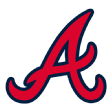
35-25 | NL East champs | 7.6% World Series odds
Odds by round
WC: 60.8% vs. Reds
NLDS: 70.7% vs. Marlins; 56.4% vs. Cubs
NLCS: 64.7% vs. Brewers; 58.3% vs. Cardinals; 39.4% vs. Padres; 26.7% vs. Dodgers
WS: 65.5% vs. Blue Jays; 62.1% vs. Astros; 50.7% vs. Yankees; 50.6% vs. Indians; 47.5% vs. White Sox; 49.5% vs. A’s; 44.2% vs. Rays; 44.1% vs. Twins
How they could go far: Rotation struggles and injuries have plagued the otherwise airtight Braves all season. The group remains uncertain as the postseason dawns. Max Fried has been spectacular but is ramping back up from injury. Rookie Ian Anderson looks good, but his track record is short. Kyle Wright has been better of late but hasn’t proven he can be consistent. Mike Soroka and Cole Hamels are out for the season. The Braves’ offense and bullpen are so strong that if the starters can simply keep the other team from leaping to large early leads, Atlanta will be in good shape. — Doolittle
How they could go home before you’re done reading this: The key for the pitching staff might be to simply keep the ball in the park. Atlanta’s pitchers ranked 23rd in strikeout rate, but no pitching staff gave up a lower rate of its runs via the homer (35%). If they can maintain that into October, then the Braves’ below-average team defense can do only so much damage. The run prevention doesn’t have to be perfect because Atlanta might have the best offense in baseball. — Doolittle
Most likely October hero: Freddie Freeman is the heart and soul of the Braves and he has become better than ever at the plate, hitting not just for power, but hitting for average and cutting down on his strikeouts (he had more walks than K’s for the first time). His numbers against righties are ridiculous this year, so it will be interesting to see if teams pitch around him and try to make Marcell Ozuna beat them. — Schoenfield
Matchup to watch in Round 1: Braves hitters versus Reds fastballs. Well, this will be fun. The second-best offense in the majors (the Dodgers crept just ahead of the Braves in runs per game, 5.82 to 5.80) against the dynamic rotation of the Reds. The Braves led the majors in wOBA against fastballs, hitting .304 and slugging .547. Game 2 starter Luis Castillo had the second-highest swing rate among starters on his fastball at 37.1% (four-seamer or two-seamer), but batters hit .300 and slugged .525 against his fastballs. Game 1 starter Trevor Bauer had a much lower swing-and-miss rate (23%), but batters hit just .141 against his fastball. — Schoenfield
Their only-in-2020 stat: For every fan who is constantly aggrieved by their favorite team’s inability to move a runner over or get a runner in with less than two outs, be soothed: The Braves’ offense this season has by far the lowest percentage of “productive” outs — either advancing a runner with no outs, or scoring a runner from third with one out. With runners on third with less than two outs, they have the worst record of driving the run home. Meanwhile, they were second in the majors in scoring, with nearly six runs per game — the most by the franchise since the 1800s. — Miller
One bold prediction: Anderson will become the first Braves rookie to throw at least six shutout innings in a playoff game. — Passan
3. Chicago Cubs
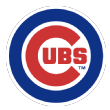
34-26 | NL Central champs | 4.5% World Series odds
Odds by round
WC: 63.9% vs. Marlins
NLDS: 57.7% vs. Reds; 43.6% vs. Braves
NLCS: 59.2% vs. Brewers; 52.5% vs. Cardinals; 33.9% vs. Padres; 22.2% vs. Dodgers
WS: 60.0% vs. Blue Jays; 56.4% vs. Astros; 44.9% vs. Yankees; 43.7% vs. A’s; 42.3% vs. Indians; 39.4% vs. White Sox; 38.5% vs. Rays; 38.4% vs. Twins
How they could go far: Chicago’s core has been in place for a long time, and its best players — Anthony Rizzo, Kris Bryant, Javier Baez — are among the most recognizable stars in the game. Bryant returned from his oblique tweak over the weekend (and hit a grand slam), so the guys are all lined up for another playoff run. The Cubs squeezed by during the regular season in a weak division with that trio well under .700 in OPS most of the way. But the key Cubbies have to hit like full-grown bears if there is to be any hope of a 2016 reprise. — Doolittle
How they could go home before you’re done reading this: David Ross has to find someone who can answer the call when he goes to the bullpen to close out games. Craig Kimbrel might be that guy. He might not. His stuff remains diminished from his once-dominant days, but he hasn’t given up a run in September. Closing games is, after all, what he is paid to do and it’s unclear if Rowan Wick (oblique strain) will be able to walk through that bullpen door. Jeremy Jeffress has gotten the job done for most of the season, but his underlying Statcast indicators suggest Ross should keep an open mind. — Doolittle
Most likely October hero: Yu Darvish has been one of the top starters in the majors since the second half of 2019, when he suddenly started pounding the strike zone like never before. He doesn’t have the reputation as a big-game pitcher, although maybe his performance in the 2017 World Series against the Astros can be excused. Still, postseason pitching is about missing bats and Darvish does that better than anybody else on the Cubs’ staff. — Schoenfield
Matchup to watch in Round 1: Yu Darvish and Kyle Hendricks versus Marlins hitters. The Marlins ranked 25th in the majors in chase rate — meaning they will chase pitches out of the strike zone. Darvish and Hendricks are two of the top strike-throwers in the majors. In fact, Darvish led all qualified starters in percentage of pitches within the strike zone (not that they were easy to hit). It will be interesting to see if the two Cubs starters deviate from their usual plan and throw more pitches off the plate to see if the Marlins chase. — Schoenfield
Their only-in-2020 stat: The expanded playoffs this year will lead to a lot of bad-for-a-playoff-team fun facts. But the Cubs didn’t sneak in through the expanded format — they actually won their division, despite having a team batting average that’s about 15 points lower than any other postseason team in history. It’s not the bottom of the order; it’s the Cubs’ stars, with Baez, Bryant and Kyle Schwarber at or below .200. The Cubs’ top five spots in the order: .211, .217, .204, .190, .211. — Miller
One bold prediction: The Cubs’ offense — which has been positively wretched in September, with its .215/.299/.340 slash resembling the career line of pitcher Zack Greinke — is going to break out in the wild-card series and put up multiple crooked numbers. — Passan
4. San Diego Padres

37-23 | second place, NL West | 11.1% World Series odds
Odds by round
WC: 63.1% vs. Cardinals
NLDS: 70.4% vs. Brewers; 36.7% vs. Dodgers
NLCS: 80.4% vs. Marlins; 72.5% vs. Reds; 66.1% vs. Cubs; 60.6% vs. Braves
WS: 73.8% vs. Blue Jays; 70.7% vs. Astros; 61.3% vs. A’s; 60.1% vs. Yankees; 60.0% vs. Indians; 57.0% vs. White Sox; 56.0% vs. Twins; 53.7% vs. Rays
How they could go far: Early in the season, the Padres’ post-Kirby Yates bullpen was the glaring area of concern. According to FanGraphs, San Diego’s revamped relief staff leads the majors in bullpen WAR since Sept. 1. Lately, the offense has mildly slumped and that’s a concern if the small-sample droughts of Eric Hosmer, Fernando Tatis Jr., et al, extend into October. Above all else, the very recent injuries to Mike Clevinger and Dinelson Lamet put the onus on the rotation, whether or not they are able to go. Because if the Padres’ starters perform in the postseason, this is a complete team that can go toe-to-toe with anyone. Well, except maybe the Dodgers. Perhaps the overriding dilemma facing the Padres is that everything they do, the Dodgers do just a little bit better. — Doolittle
How they could go home before you’re done reading this: About that lineup … according to the leading contextualized team metrics, the Padres have been a top-five offensive club. That the roll has slowed a bit over the past couple of weeks is more a thing to keep in mind than a clear indicator of impending doom. Another thing about the Padres’ offense is that only one team has been more reliant on homers for its scoring than San Diego. That doesn’t have to be a bad thing. All of the leading teams in the homer-based offense category are winning teams. However, if the sources of power are thinned out by ill-timed slumps and playoff-caliber pitching, then an inability to turn the scoreboard could make the Padres’ return trip to the playoffs a short one. — Doolittle
Most likely October hero: As much as we love Tatis, his late-season slump is a cause for concern and he performed much better against bad teams. So let’s go with Lamet. Postseason history is filled with young power pitchers who come up big (although at 28 he’s not that young). Think of pitchers such as Jose Rijo for the Reds in 1990 or Josh Beckett for the 2003 Marlins or Nathan Eovaldi for the Red Sox in 2018. Postseason experience is overrated and Lamet had a terrific regular season, misses a ton of bats and has the big fastball/wipeout slider combo. — Schoenfield
Matchup to watch in Round 1: Fernando Tatis Jr. and Jake Cronenworth versus Cardinals pitchers. Tatis was the runaway MVP leader after the first month-plus of the season but hit .208/.311/.403 in September. Cronenworth was the runaway Rookie of the Year leader after the first 30-plus games but hit .183/.275/.268 in September. — Schoenfield
Their only-in-2020 stat: The 1977 White Sox plugged their catchers into the last slot in the batting order and apparently never thought about that decision again; the result, when those catchers (Jim Essian and Brian Downing) each had great years, was a .375 OBP in the No. 9 spot, the highest ever. The Padres this year — with no pitchers batting — walloped that record. Their No. 9 hitters — 10 different players have started in that spot, with Jurickson Profar leading the way — have a .385 OBP. It’s partly a testament to the Padres’ lineup depth, and partly just one of those weird things, considering the No. 9 hitters have actually outhit the club’s cleanup hitters. — Miller
One bold prediction: The most impressive thing about the Padres isn’t going to be their offensive might or starting pitching. It will be a bullpen led by Trevor Rosenthal, Drew Pomeranz and Austin Adams, who recently returned from knee surgery equipped with his devastating slider. — Passan
5. St. Louis Cardinals

30-28 | second place, NL Central | 1.9% World Series odds
Odds by round
WC: 36.9% vs. Padres
NLDS 54.3% vs. Brewers; 24.4% vs. Dodgers
NLCS: 67.2% vs. Marlins; 57.2% vs. Reds; 47.5% vs. Cubs; 41.7% vs. Braves
World Series: 58.8% vs. Blue Jays; 55.2% vs. Astros; 42.4% vs. A’s; 41.2% vs. Yankees; 41.1% vs. Indians; 38.1% vs. White Sox; 37.3% vs. Rays; 37.2% vs. Twins
How they could go far: The Cardinals need to keep scores low, even lower than you typically see in a tight postseason contest. To do that, they must keep the ball in the yard. St. Louis ranked fifth in limiting runs per game by means other than a home run. They were more middle of the pack when it came to giving up runs on homers. When you look at the teams in the Cardinals’ path — the Padres, the Dodgers, pretty much every club in the postseason — they feature attacks built around the long ball. If only the Cardinals could play against themselves. — Doolittle
How they could go home before you’re done reading this: St. Louis badly needs to hit a few bombs. The Cardinals have a reliable if unspectacular rotation. The bullpen has been in flux but suddenly looks like a strength with Alex Reyes morphing into the new Mariano Rivera. The offense has not been good, but collectively the St. Louis hitters get on base at an acceptable clip. That’s where the troubles begin: The Redbirds ranked 27th in slugging, and dead last in both homers and isolated power. It’s hard to score in the postseason and teams need a few home runs to survive. The good news is that in guys like Paul Goldschmidt, Matt Carpenter, Paul DeJong and Yadier Molina, St. Louis has hitters who are capable of going deep. If they don’t, the Cardinals won’t score enough to beat the beasts of the National League. — Doolittle
Most likely October hero: Look, when the Cardinals win, the heroes are never who you would expect. In 2006, the NLCS MVP was Jeff Suppan and the World Series MVP was David Eckstein. In 2011, David Freese took home both honors. The NLCS MVP in 2013 was rookie Michael Wacha. So we’re probably looking at, oh, Brad Miller, a guy who has been released by the Brewers and Dodgers in recent years, waived by the Indians and given up for cash by the Yankees. — Schoenfield
Matchup to watch in Round 1: RISP versus RISP. The Padres led the majors with a .310 average and .569 slugging with runners in scoring position (remember all those grand slams!). The Cardinals gave up a .222 average with RISP, second lowest in the majors to the Dodgers. Adam Wainwright was especially good in this area, holding batters to a .171 average and .195 slugging. — Schoenfield
Their only-in-2020 stat: On Sept. 1, ahead 11-0, Andrew Knizner pinch hit for Goldschmidt and grounded a single up the middle. That marks the only pinch-hit for the Cardinals this year. Collectively, they’re 1-for-29, for an .034/.125/.034 line. (It could, technically, be worse; the Diamondbacks’ pinch hitters are 0-for-22, though with a higher on-base percentage.) — MIller
One bold prediction: Jack Flaherty will strike out at least 10 batters in his first start this postseason. — Passan
6. Miami Marlins

31-29 | second place, NL East | 0.5% World Series odds
Odds by round
WC: 36.1% vs. Cubs
NLDS: 42.5% vs. Reds; 29.3% vs. Braves
NLCS: 39.1% vs. Brewers; 32.8% vs. Cardinals; 19.6% vs. Padres; 11.5% vs. Dodgers
WS: 38.8% vs. Astros; 39.9% vs. Blue Jays; 27.3% vs. A’s; 26.2% vs. Yankees; 26.2% vs. Indians; 23.7% vs. White Sox; 23.1% vs. Rays; 23.0% vs. Twins
How they could go far: The Marlins will go on a run if they can channel the magic of the only two previous South Beach teams to make the postseason. Miami is one of the season’s great stories and this has been a season in which we needed great stories. But as any good Gen-Xer knows, reality bites. The Marlins reached .500 and clinched a playoff spot despite a run differential that was by far the worst in the NL East. However, there is always hope. The memorable title runs of 1997 and 2003 were fueled by young pitchers who were hot at the right time. In Sixto Sanchez, Pablo Lopez, Sandy Alcantara and Trevor Rogers, the 2020 Marlins have the right ingredients to remake that exact recipe. — Doolittle
How they could go home before you’re done reading this: The Marlins have been shut out as often as any offense in baseball. They’re a team with no clear-cut offensive strength, just a bunch of veteran types who put up just enough tallies to give the pitching staff a chance on most nights. Against elite pitching, that’s a fraying tightrope that has to be traversed. It’s not hard to envision a scenario in which the Marlins hang tough for a couple of games but just can’t put enough crooked numbers on the board to keep going. Someone from this unsung bunch needs to get hot. — Doolittle
Most likely October hero: We have to go with Sanchez because if the Marlins do anything, it probably will be because the starting pitching gets on a roll. Plus, Sanchez fits in perfectly with Marlins history. Livan Hernandez was a 22-year-old rookie in 1997 when he won NLCS and World Series MVP honors. Josh Beckett was 23 in 2003, a second-year pitcher, when the Marlins won it all again. Sanchez is just 22 and has fewer than 10 career starts but has the best stuff on the staff. — Schoenfield
Matchup to watch in Round 1: The Marlins aren’t a big power team, but they did finish second to the Padres in stolen bases, so let’s see if Don Mattingly tries to generate some offense on the basepaths. Utilityman Jon Berti, who has been starting at second base down the stretch, is the top threat, with Starling Marte, Lewis Brinson and Miguel Rojas also threats to run. — Schoenfield
Their only-in-2020 stat: Thanks to quarantines, makeup doubleheaders and midseason trades, the Marlins used 61 players, including 37 pitchers — the most in franchise history, despite the short season. A lot of these pitchers worked only an inning or five, planting themselves in some future franchise trivia question while, collectively, torching the club’s pitching stats. The 15 Marlins who threw the most innings this year had a collective ERA of 4.23, which would put them in the top half of the league. The 22 short-timers had an ERA over 7.00, swelling the club’s overall ERA to almost 5.00 — painting a somewhat distorted, somewhat misleading picture of the Marlins’ staff heading into the postseason. — Miller
One bold prediction: The Marlins don’t start their uber-talented rookie, Sanchez, in Game 1 of the wild-card series. — Passan
7. Cincinnati Reds

31-29 | NL seventh seed | 1.7% World Series odds
Odds by round
WC: 39.2% vs. Braves
NLDS: 60.4% vs. Marlins; 42.3% vs. Cubs
NLCS: 49.5% vs. Brewers; 42.8% vs. Cardinals; 27.5% vs. Padres; 17.3% vs. Dodgers
WS: 50.3% vs. Blue Jays; 49.2% vs. Astros; 36.6% vs. A’s; 35.4% vs. Yankees; 35.4% vs. Indians; 32.5% vs. White Sox; 31.8% vs. Rays; 31.7% vs. Twins
How they could go far: Happily for Reds fans, if the one-dimensional Cincinnati offense gets a few long pokes, their club enters the playoffs with one of the best pitching staffs around to nurse a lead. The rotation works deep, led by the big three of Trevor Bauer, Luis Castillo and Sonny Gray, which should allow manager David Bell to parse out high-leverage innings if the Reds advance to the later rounds, thus preserving his top bullpen arms. That’s all the Reds need, is a few homers here and there. If the Reds’ starters get a modicum of run support, Cincinnati will be a nightmare playoff opponent for any team, as Joey Votto suggested. — Doolittle
How they could go home before you’re done reading this: In this home run-heavy era, you can say that every team needs to hit home runs to do well in the playoffs. You can say that for every team, but it won’t be as true for every team as it is for the Reds. Simply put, this is one of the most extreme offensive teams in the history of baseball. The Reds finished with a historically low batting average that belongs on sepia-colored baseball cards put out by tobacco companies. They ranked 21st in wRC+, per FanGraphs, just to cite one contextual measure. That they did as well as they did was because of a homer-based offense that ranked fifth in runs per game via homers. Alas, the Reds finished dead last in runs by non-homer means by a mile. Cincinnati has to hit homers or it won’t survive, no matter how well its pitching staff does. — Doolittle
Most likely October hero: Bauer’s rubber arm means he can pitch deep into games and could start on short rest or even pitch in relief, but the Reds are going to need offense from somewhere, and after a dreadful first month, Eugenio Suarez has been back to pounding home runs the way he did last season, when he hit 49. He leads the majors in home runs since the second half of 2019. — Schoenfield
Matchup to watch in Round 1: Reds hitters versus BABIP. The Reds hit just .212 — the lowest average ever for a playoff team and the second-lowest average ever, period (the 1910 White Sox hit .210). But the Reds also finished with a .245 average on balls in play, the lowest since the 1968 Yankees. According to Statcast metrics, their expected batting average based on quality of contact should have been .242. Maybe that would have evened out over 162 games. The Reds need it to even out over the next two or three games (and hopefully beyond). — Schoenfield
Their only-in-2020 stat: In a season of so many low-batting-average fun facts, this one is the most fun/least fun of all: The Reds’ team batting average on balls in play is an unfathomable .245, the lowest by any team since the Year Of The Pitcher in 1968, the second lowest since the end of the deadball era in 1920, an incredible 20 points lower than any other team in baseball this year, and one point better than pitchers hit last year. The Reds are fourth in the NL in homers, second in the NL in walks — and are second from the bottom in scoring. (Bonus Reds stat: Their Nos. 7-8-9 hitters have a higher OPS than their Nos. 1-2 hitters, or their Nos. 3-4-5-6 hitters.) — Miller
One bold prediction: The Reds’ bullpen is going to blow a lead early in the postseason and jeopardize the team’s good fortune of being in a short series with superior starting pitching. — Passan
8. Milwaukee Brewers
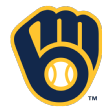
29-31 | NL eighth seed | 0.7% World Series odds
Odds by round
WC: 24.6% vs. Dodgers
NLDS: 45.7% vs. Cardinals; 29.6% vs. Padres
NLCS: 60.9% vs. Marlins; 50.5% vs. Reds; 40.8% vs. Cubs; 35.3% vs. Braves
WS: 52.1% vs. Blue Jays; 48.4% vs. Astros; 37.1% vs. Yankees; 36.0% vs. A’s; 34.7% vs. Indians; 31.9% vs. White Sox; 31.2% vs. Rays; 31.0% vs. Twins
How they could go far: The key for the Brewers could hardly be more simple: They have to get the ball to the back of the bullpen with a lead. Of course, the goal might be simple, but the steps to reach it are impossibly complex. Milwaukee’s starters have to get the ball to Josh Hader and Devin Williams against the unsolvable Dodgers’ offense. The good news is that they’ll be able to deploy Brandon Woodruff in one of the wild-card games. The bad news is that they won’t be able to do the same with co-ace Corbin Burnes, who is laid up with an oblique strain. And even if Milwaukee’s pitching can string up zeroes, a team that hit .223 as a unit has to put up some runs against an elite pitching staff. — Doolittle
How they could go home before you’re done reading this: Given the Brewers’ offensive struggles, one early three-run homer allowed by a starter could sink them and take their high-powered bullpen out of high-leverage possibilities. Who is most likely to provide the needed lead? That would be former MVP Christian Yelich, who is coming off his worst season. It’s not going out on a limb to call the Brewers a flawed team. After all, they made the playoffs with a losing record. But there seem to be few scenarios in which Milwaukee goes on a Cinderella run without a suddenly resurgent Yelich. — Doolittle
Most likely October hero: OK, maybe it will be Yelich or Ryan Braun in what could be his swan song in Milwaukee (he has a club option for 2021 that might not be picked up), but let’s go with Daniel Vogelbach to become a Milwaukee legend and lead the under-.500 Brewers to their first World Series. Sure, the Mariners sent him to the Blue Jays for cash, and the Blue Jays waived him after a couple of games, but he’s hot, hitting .328/.418/.569 in 19 games with the Brewers. — Schoenfield
Matchup to watch in Round 1: Hader and Williams versus Dodgers hitters. Really, Craig Counsell will have to work his two ace relievers as hard as reasonably possible — including using them earlier than the eighth inning if the game is on the line. In fact, if the Brewers are up after five innings in the opener, he shouldn’t shy away from trying to use both of them for two innings apiece if the game is on the line. Remember, there are at least three off days between the final game of the wild-card series and the first game of the NLDS, so you can use them heavily for three games. — Schoenfield
Their only-in-2020 stat: The Brewers’ offense was terrible — only their right-fielders hit better than league average for their position — but they still managed to score enough runs to make the playoffs. Their trick? They hit much, much better with men on base, clustering their few hits enough to score runs. Only one team this century — the 2013 Cardinals — had a bigger bump in their offense with runners on base than the Brewers, which helped them finish a slightly respectable 13th in the NL in scoring this year. — Miller
One bold prediction: Brewers relievers will end the postseason with more innings pitched than their starting pitchers, which may not be altogether bold considering Craig Counsell’s history of relying on his bullpen but nevertheless is still an odd reality. — Passan
American League
1. Tampa Bay Rays

40-20 | AL East champs | 8.8% World Series odds
Odds by round
WC: 64.8% vs. Blue Jays
ALDS: 54.9% vs. Yankees; 54.9% vs. Indians
ALCS: 66.3% vs. Astros; 56.5% vs. A’s; 52.1% vs. White Sox; 51.1% vs. Twins
WS: 76.9% vs. Marlins; 68.8% vs. Brewers; 68.2% vs. Reds; 62.7% vs. Cardinals; 61.5% vs. Cubs; 55.8% vs. Braves; 46.3% vs. Padres; 30.6% vs. Dodgers
How they could go far: You don’t really prescribe that a team play lots of close games, but that remains a game type that seems to favor the Rays. They pitch. They catch. They hit timely homers. Tampa Bay always seeks to maximize discrete matchups, but when you look at four possible rounds of the playoffs, and the number of injuries that have sapped the Rays’ pitching depth, it does seem for Tampa Bay to make it to the finish line, it will need to get some length from its starters. If Charlie Morton, Tyler Glasnow and Blake Snell are both effective and efficient, look out. — Doolittle
How they could go home before you’re done reading this: The Rays see a lot of pitches and, as a group, don’t chase much. When they swing, only one club makes a lower percentage of contact. But when contact is made, damage is done. Only three teams have a higher slugging percentage on contact than Tampa Bay. Whether it’s hard stuff, soft stuff or breaking stuff, the Rays seek to force a pitcher into the zone, then they jump on him. Alas, patience can lapse into passivity, and when you go against postseason-ready pitching staffs, it can become a vice. The Rays need to balance aggression and patience before called third strikes start leading to a string of zeros. — Doolittle
Most likely October hero: No team wants to face Glasnow in the postseason, even if his 2020 ERA didn’t match the 1.78 figure he put in 12 starts in 2019. Still, here’s the number that stands out: 14.6 K’s per nine innings. Whoa. Yeah, when you’re 6-foot-8 and average 97 mph with a high-spin fastball and wipeout breaking ball, you’re going to rack up the K’s. He did give up some home runs, his command was shaky at times and the Rays were careful with his pitch count (more than 100 pitches only twice), but he is the swing-and-miss type pitcher who can dominate for a month. — Schoenfield
Matchup to watch in Round 1: Strikeouts versus strikeouts. Rays pitchers led the AL in strikeouts — as Kevin Cash alluded to after Aroldis Chapman threw at the Rays in an early September game, the Rays “have a whole damn stable of guys who throw 98 mph” — but only the Tigers struck out at a higher rate across MLB. The offense also had one of the highest walk rates, however, as the Rays have morphed into a real “three true outcomes” type of lineup. — Schoenfield
Their only-in-2020 stat: The Rays rarely let their starters face batters three (or more) times in a start, and their own hitters show the reason why: Tampa Bay hitters have slugged over .560 against starters the third time around. Rays hitters are collectively 47% better the third time through the order than they are overall, which is the AL’s biggest third-time-through bump since 2000. — Miller
One bold prediction: Reliever Nick Anderson will win ALCS MVP. — Passan
2. Oakland Athletics
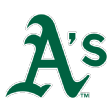
36-24 | AL West champs | 4.8% World Series odds
Odds by round
WC: 49.0% vs. White Sox
ALDS: 60.2% vs. Astros; 46.8% vs. Twins
ALCS: 64.9% vs. Blue Jays; 50.0% vs. Yankees; 49.9% vs. Indians; 43.5% vs. Rays
WS: 72.7% vs. Marlins; 64.0% vs. Brewers; 63.4% vs. Reds; 57.6% vs. Cardinals; 56.3% vs. Cubs; 50.5% vs. Braves; 38.7% vs. Padres; 26.2% vs. Dodgers
How they could go far: A long run in the postseason for Oakland would seem to require two things: a competent performance from the Athletics’ middle-of-the-pack rotation, and third baseman Jake Lamb continuing his impressive Matt Chapman imitation. The rotation question has plagued Oakland through its run of success in recent years. This time around, there are good options, even if we don’t quite know how things will set up. Chris Bassitt, Jesus Luzardo and Sean Manaea all figure to be key parts of the puzzle. As for Lamb, who was set adrift by Arizona, he actually has hit better than Chapman did before the latter’s season was cut short by injury. He also has played a mistake-free third base, albeit without Chapman’s all-world zeal at the position. — Doolittle
How they could go home before you’re done reading this: The A’s led the majors with a sub-2.50 bullpen ERA and feature one of the game’s best closers in Liam Hendriks. But as mentioned, the rotation is more competent than spectacular, and the offense likewise has been middling. If Oakland can take leads into the middle innings, it will be a tough out for any opponent. Otherwise, it’ll be up to a .220-ish hitting offense to save the day. Getting lots of early leads seems like the surer path. — Doolittle
Most likely October hero: There’s no obvious answer here, but let’s go with Hendriks, who has basically been lights out now for two seasons. The bullpen is the team’s strength, so if the A’s win it will be because the pen locks down every lead they get. Bob Melvin has used Hendriks more than one inning in only a couple of outings, but he did do it regularly last season, so he’s certainly couple of four- or five-out saves. — Schoenfield
Matchup to watch in Round 1: A’s hitters versus breaking balls. The A’s were middle of the pack against four-seam fastballs, but only the Rangers and Reds had a lower batting average than Oakland’s .173 mark against curveballs and sliders. Matt Olson and Marcus Semien both hit under .150 against breaking balls. — Schoenfield
Their only-in-2020 stat: No matter how you split it up, the A’s bullpen looks pretty good — the team had, after all, the league’s best bullpen ERA. But the relievers were especially good with one day of rest, with a 1.52 ERA that’s the best by any bullpen since 1988. The bad news is that, with urgency of October baseball and this year’s compressed postseason schedule, Oakland might not have the luxury of having many days of rest. — Miller
One bold prediction: The A’s best hitter this postseason will be catcher Sean Murphy, who has been under-the-radar excellent in his first taste of full-time duty and is a burgeoning All-Star. — Passan
3. Minnesota Twins

36-24 | AL Central champs | 8.7% World Series odds
Odds by round
WC: 62.5% vs. Astros
ALDS: 56.1% vs. A’s; 52.3% vs. White Sox
ALCS: 69.7% vs. Blue Jays; 55.4% vs. Yankees; 55.3% vs. Indians; 48.9% vs. Rays
WS: 77.0% vs. Marlins; 69.0% vs. Brewers; 68.3% vs. Reds; 62.8% vs. Cardinals; 61.6% vs. Cubs; 55.9% vs. Braves; 44.0% vs. Padres; 30.7% vs. Dodgers
How they could go far: Minnesota doesn’t have the most diverse offense of teams in the postseason. Not only do the Twins lean heavily on long hits to score runs, they do the majority of that damage against right-handed pitchers. The Twins led the American League in overall home run percentage. They also led the league in HR% off righties, and it wasn’t particularly close. The numbers were polar opposite against left-handers: Minnesota finished dead last in the AL in HR% off lefties. Thus the Twins have two choices: solve southpaws, or avoid them. The strengths of several of Minnesota’s possible playoff obstacles suggest taking the former path. — Doolittle
How they could go home before you’re done reading this: As we all remember, the Twins set the team home run record during the 2019 season. This season, they are among the leaders in team homers but are just one of the top-tier clubs, not above them. Yet, the Minnesota attack has been more dependent on homers for scoring than any other team on the AL side of the tournament, with 51% of the Twins’ runs coming via the long ball. Conversely, no team in the AL — playoff entrant or not — has scored fewer runs per game by non-homer means. The Twins need to go deep during games to go deep into the tournament. — Doolittle
Most likely October hero: Nelson Cruz was not only the best hitter on the Twins during the regular season, but he has been one of the best sluggers in postseason history. He has hit .287/.354/.659 in 44 postseason games, with 17 home runs and 35 RBIs, most memorably hitting six home runs in the 2011 ALCS for the Rangers. Granted, most of that came earlier in his career (he has played in only one postseason since 2014), but he’s arguably better than ever at the plate. — Schoenfield
Matchup to watch in Round 1: Twins batters versus Zack Greinke. After a hot start, Game 1 starter Greinke gave up at least three runs in each of his final seven starts (5.73 ERA). Batters hit .321 and slugged .536 against Greinke’s four-seamer — the pitch he throws most often. The Twins best hitters against four-seam fastballs: Cruz slugged .868 and Miguel Sano slugged .635. — Schoenfield
Their only-in-2020 stat: There are a lot of things that separate the teams at the top of the AL Central from the bottom, but here’s one: When a runner gets to third base with fewer than two outs this year, Tigers pitchers have been able to strike out the batter 10% of the time. The Twins, meanwhile, have struck that batter out 30% of the time, best in baseball. — Miller
One bold prediction: The Twins will win a playoff game. That’s not bold, you say? Considering they have lost their past 16, I’d posit that it more than qualifies, thank you very much. — Passan
4. Cleveland Indians
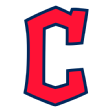
35-25 | second place, AL Central | 6.5% World Series odds
Odds by round
WC: 52.1% vs. Yankees
ALDS: 64.3% vs. Blue Jays; 45.1% vs. Rays
ALCS: 62.7% vs. Astros; 48.2% vs. White Sox; 50.1% vs. A’s; 44.7% vs. Twins
WS: 73.8% vs. Marlins; 65.3% vs. Brewers; 64.6% vs. Reds; 58.9% vs. Cardinals; 57.7% vs. Cubs; 51.9% vs. Braves; 40.0% vs. Padres; 27.3% vs. Dodgers
How they could go far: The Indians keep opponents off the scoreboard as well as anyone. That’s the good news. The bad news is that there isn’t much they do well on offense beyond draw walks. It’s possible that red-hot star Jose Ramirez keeps raking and carries the attack, and is even joined by his infield star cohort, Francisco Lindor. Beyond them, Indians hitters need to keep drawing free passes, move runners and come through in scoring situations, which they did not do well during the regular season. — Doolittle
How they could go home before you’re done reading this: If the starters falter, particularly Shane Bieber, Cleveland is doomed. This is pretty straightforward. The Indians lean on their rotation as much as any team in baseball. As a group, Cleveland pitchers have given up the fewest runs per game on home runs — a key metric for the postseason. But they also led the majors in limiting runs allowed by means other than the long ball. The Indians are just hard to score against. Any lengthy Cleveland run involves those trends continuing after the October leaves have turned. — Doolittle
Most likely October hero: If you’re picking one pitcher to go all Madison Bumgarner this postseason, you have to pick Bieber, the most dominant pitcher in the regular season. I don’t know if Terry Francona (or acting manager Sandy Alomar Jr.) would consider using him on short rest at any point the way he did with Corey Kluber three times in the 2016 postseason, but if the Indians go deep into October, it’s probably because Bieber is winning some low-scoring games. — Schoenfield
Matchup to watch in Round 1: Indians “power” hitting versus Yankees pitching. Cleveland ranked just 26th in the majors in isolated power — but Yankees pitchers gave up 83 home runs, fifth worst in the majors and the most of any playoff team. Gerrit Cole (14 in 73 IP), Masahiro Tanaka (nine in 48 IP) and J.A. Happ (eight in 49⅓ IP) were all vulnerable to the long ball. — Schoenfield
Their only-in-2020 stat: Cleveland’s catchers have the worst offensive production of any team’s catchers in at least 100 years. But Roberto Perez, Austin Hedges and Sandy Leon might be the best defensive catchers any team has ever gathered, and they have coaxed Cleveland’s pitching staff to the league’s best ERA+ in at least 100 years. Cleveland’s catchers have the American League’s best caught-stealing rate, the fewest passed balls (zero!) and are close to the bottom in wild pitches. Perez and Hedges are also both elite-level pitch framers. Their collective batting line — .128/.242/.189 — is almost impossible to believe, barely better than pitchers used to hit. But depending on how much of the pitching staff’s success you credit to the batterymates, it might be worth it. — Miller
One bold prediction: In a postseason game, Bieber will give up more runs than he has in any of his other 2020 starts. (The target number: four or more. Yes, Bieber, he of the 1.68 ERA, limited opponents to three or fewer runs in all 12 of his starts this season.) — Passan
5. New York Yankees

33-27 | second place, AL East | 5.0% World Series odds
Odds by round
WC: 47.9% vs. Indians
ALDS: 64.2% vs. Blue Jays; 45.1% vs. Rays
ALCS: 62.6% vs. Astros; 50.0% vs. A’s; 45.6% vs. White Sox; 44.6% vs. Twins
WS: 73.8% vs. Marlins; 65.2% vs. Brewers; 64.6% vs. Reds; 58.8% vs. Cardinals; 55.1% vs. Cubs; 49.3% vs. Braves; 39.9% vs. Padres; 27.2% vs. Dodgers
How they could go far: The Yankees don’t have a completely one-dimensional offense, but we’ve seen what they do best: club the ball over the fence. After injuries cast their season into temporary peril, the Bombers got mostly healthy and the homers started piling up like tote bags at a literary festival. And yet, established sluggers Giancarlo Stanton, Aaron Judge and Gary Sanchez haven’t added much to the long-ball surge. Sanchez might be on the outs, but if Stanton and Judge both get hot, there might be no one who can outscore the Yankees. — Doolittle
How they could go home before you’re done reading this: Given the explosiveness of the offense and the depth of the fireballing bullpen, the Yankees’ starters don’t have to work deep. There is one exception to that in Gerrit Cole. Cole hasn’t been quite as dominant as he was in 2019, but he has been pretty good and the Yankees need him to be at his best in the weeks to come. With four rounds to traverse and no rest days during series, Cole is going to have to be a one-man breather for the relief staff, going at least seven innings and shortening games. If Cole isn’t quite himself and gets bitten by the long-ball bug as he has at times during the regular season, it’ll be hard for the Yankees to survive the rugged AL bracket. — Doolittle
Most likely October hero: Cole is the easy choice and he looks locked in heading into October, but let’s go with DJ LeMahieu, who might have a claim for AL MVP honors if not for a two-week stint on the IL. LeMahieu is the kind of hitter who can excel in the postseason not only because he’s a high-average hitter with some pop, but because he doesn’t strike out. Only Tommy La Stella among qualified regulars had a lower strikeout rate. — Schoenfield
Matchup to watch in Round 1: So how do you beat Shane Bieber? He doesn’t give up many hits, walks about two batters per nine innings and averaged 14.2 K’s per nine. You can try to run up his pitch count — he had two five-inning starts this year with 103 and 98 pitches. But if you try to work the count and get to two strikes, batters hit just .096. He did give up seven home runs in 77⅓ IP, but even then they came off four different pitches, so it’s not as if he’s particularly vulnerable to a 1-0 fastball or something if he falls behind in the count. His least effective pitch was his cutter, against which batters hit .289/.325/.474. So, umm, yeah, we don’t know how you beat him either. — Schoenfield
Their only-in-2020 stat: Since 1993, the 20 largest splits between a team’s offense at home and its offense on the road: 19 Rockies seasons, and this year’s Yankees. Sanchez’ OPS is 300 points higher at home than on the road; Luke Voit‘s is 400 points higher at home; LeMahieu’s is 500 points higher. Unlike those Rockies splits, the difference isn’t offset on the pitching side, as Yankees pitchers have given up 1.75 fewer runs per game at home. Alas, they’ve played their final home game of 2020. — Miller
One bold prediction: The Yankees will not go to the World Series, marking 11 consecutive years and tying the second-longest drought in franchise history. The darkest time for the franchise: The 13 years from 1982 to 1995 during which champions were crowned and the Yankees weren’t once in the picture. — Passan
6. Houston Astros
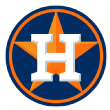
29-31 | second place, AL West | 1.5% World Series odds
Odds by round
WC: 37.5% vs. Twins
ALDS: 39.8% vs. A’s; 36.2% vs. White Sox
ALCS: 52.4% vs. Blue Jays; 37.4% vs. Yankees; 37.3% vs. Indians; 33.7% vs. Rays
WS: 61.2% vs. Marlins; 51.6% vs. Brewers; 50.8% vs. Reds; 44.8% vs. Cardinals; 43.6% vs. Cubs; 37.9% vs. Braves; 29.3% vs. Padres; 18.6% vs. Dodgers
How they could go far: As simple and crude as it sounds, the Astros will start to resemble the Astros who have rolled through the American League in recent years if they start hitting the ball over the fence. Overall, Houston ranks in the middle of the pack in scoring. Only 39% of its runs have been scored on homers, and the Astros rank 20th in runs per game via the long ball. At its best, we know the Houston attack is a robust assault that features plenty of contact, line drives into the gap and daring on the basepaths. Even during this down season, only three teams have averaged more runs per game by means other than homers. If the likes of George Springer, Carlos Correa, Alex Bregman and Jose Altuve find their home run strokes, the team many don’t want to see back in the later rounds could end up back in the later rounds. — Doolittle
How they could go home before you’re done reading this: However the offense fares, it might not matter if what necessity has turned into one of baseball’s youngest pitching staffs isn’t ready for the bright lights of bubble baseball. Houston does have a few proven arms to lean on, like Zack Greinke, Ryan Pressly and Lance McCullers Jr. But there will be more unproven pitchers facing high-leverage playoff situations than in the past few years, and any high-leverage spot can be the fulcrum on which a team’s fortunes tip one way or the other. The spotlight is about to shine on Andre Scrubb, Blake Taylor, Jose Urquidy and Cristian Javier, among others. — Doolittle
Most likely October hero: The Astros’ offense was, umm, a little under the weather in 2020 — especially Altuve and Bregman — but Springer matched his career norms and has been a guy who has produced before in the postseason, most notably in the 2017 World Series when he won MVP honors. Over his past 33 playoff games, he has hit .292/.382/.650 with 13 home runs. He could have a big postseason, then earn a big deal in free agency. — Schoenfield
Matchup to watch in Round 1: Astros hitters versus Twins pitching. The Astros actually had the lowest strikeout rate in the majors — although they finished just 14th in runs per game. Twins pitching ranked sixth in strikeout rate, with relievers Trevor May and Tyler Duffey leading the way, but Game 1 starter Kenta Maeda had a career-best 32.1% K rate. Let’s see if the Astros put-the-ball-in-play offense works better than it did in the regular season. — Schoenfield
Their only-in-2020 stat: The Blue Jays played more extra-inning games than the Astros’ nine, but the Astros played much longer extra-inning games, with the only two 13-inning games in baseball this year. A cause for those long games: Houston hit a dismal .170/.254/.189 after the ninth inning, and consequently went only 2-7 in extras. It was an all-around disappointing regular season for the defending AL champs, but it would have been very easy for them to win three or four more games in extra innings alone. — Miller
One bold prediction: While the “can’t do it without the trash can” narrative is giddily peddled by those who wish ill upon the Astros, Springer and Bregman will perform as they have in postseasons past, even if it won’t be enough to overcome Houston’s paucity of pitching. — Passan
7. Chicago White Sox
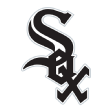
35-25 | AL seventh seed | 6.0% World Series odds
Odds by round
WC: 51.0% vs. Athletics
ALDS: 63.8% vs. Astros; 47.7% vs. Twins
ALCS: 68.9% vs. Blue Jays; 54.4% vs. Yankees; 54.3% vs. Indians; 47.9% vs. Rays
WS: 76.3% vs. Marlins; 68.1% vs. Brewers; 67.5% vs. Reds; 61.9% vs. Cardinals; 60.6% vs. Cubs; 55.0% vs. Braves; 43.0% vs. Padres; 29.9% vs. Dodgers
How they could go far: The White Sox hitters have to be disciplined against elite pitching and that has not been a strength of a moderately diverse Chicago attack. White Sox batsmen rank in the bottom five in the majors in both chase rate and contact rate, and they don’t make up for those shortcomings by taking pitches. But when they do make contact, they hit it hard, from gap to gap and over the fence. It’s a dossier that seems vulnerable to pinpoint pitching — the kind you typically see in the playoffs. Still, Chicago is a top-10 scoring offense and any hopes the White Sox have of going deep rest on the hitters creating leads that a potentially solid back of the bullpen can protect. — Doolittle
How they could go home before you’re done reading this: The White Sox will be in trouble if their hitters don’t pass the baton, so to speak, and instead try to do too much against top-flight hurlers. That would result in the club playing uphill, especially if Chicago’s tepid rotation can’t string together zeros. Because the White Sox are collectively so aggressive at the dish, not only can they be exploited by good pitchers but those same pitchers can find themselves cruising into the middle innings with low pitch counts. If Chicago finds itself going against an ace starter or two who hands the ball directly to a couple of good high-leverage relievers, it could be a brief return to the postseason for the still-green White Sox. — Doolittle
Most likely October hero: A pitcher is usually the best bet here and Lucas Giolito is lights out when he’s on, but Jose Abreu has been locked in all season and has actually performed better against good teams. Plus, after spending his first six seasons with the White Sox on losing teams, you would love to see him excel in the postseason. He’ll chase out of the zone but has destroyed fastballs better than ever this season. — Schoenfield
Matchup to watch in Round 1: White Sox hitters versus the strike zone. Not only do they have one of the highest strikeout rates in the majors (24th), but they were next to last in chase rate. Luis Robert‘s 40% chase rate led to a mammoth slump in September and Tim Anderson has managed to excel despite a similar rate. Eloy Jimenez is also above 35%. Will the better pitchers of October exploit their aggressive approach? — Schoenfield
Their only-in-2020 stat: The White Sox are second in the American League in runs per game and OPS+, and what’s especially remarkable about that is how little offense they’ve gotten from traditionally offensive positions: Their right fielders were the AL’s worst, and their designated hitters and third basemen were the AL’s second worst. Indeed, the White Sox got about 10% more production at “defense-first” positions — catcher, the middle infield and center field — than offensive positions. (First base, with Abreu, is the exception.) Since 2000, only five American League teams have gotten a more disproportionate share of their offense from defensive positions. — Miller
One bold prediction: Rookie Nick Madrigal, he of the comically low strikeout rate, will fight off pitches in a long at-bat and deliver a run-scoring single that ties a game or puts the White Sox ahead. — Passan
8. Toronto Blue Jays
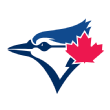
32-28 | AL eighth seed | 1.1% World Series odds
Odds by round
WC: 35.2% vs. Rays
ALDS:: 35.8% vs. Yankees; 35.7% vs. Indians
ALCS: 47.6% vs. Astros; 35.1% vs. A’s; 31.1% vs. White Sox; 30.3% vs. Twins
WS: 60.1% vs. Marlins; 49.7% vs. Reds; 43.6% vs. Cardinals; 47.9% vs. Brewers; 40.0% vs. Cubs; 34.5% vs. Braves; 26.2% vs. Padres; 16.3% vs. Dodgers
How they could go far: Charlie Montoyo is tasked with putting together a playoff bullpen on the fly on an evolving Toronto roster. The Blue Jays had two rookie pitchers who raised eyebrows during the season, reliever Jordan Romano and starter Nate Pearson. Both were injured and on the sidelines for the Blue Jays’ stretch run. Pearson was activated late in the campaign and should work in a bullpen role. Romano is aimed at getting back in action for the playoffs, though it’s not a sure bet. When you look at a rotation that needs the best from its top two of Hyun-Jin Ryu and Taijuan Walker just to keep Toronto in games, it seems like a surprise Blue Jays run could be fueled by Romano and Pearson coming together in a dynamic ad-hoc October bullpen. — Doolittle
How they could go home before you’re done reading this: The Toronto offense is fueled by talented young bats, but the offense has been an uneven, feast-or-famine outfit for most of the campaign. After a ragged start, Vladimir Guerrero Jr. has been mashing of late. Unfortunately, after carrying the Toronto offense in the opening weeks, Bo Bichette and Teoscar Hernandez have been so-so after returning from injury. The Blue Jays’ defense rates from below average to terrible, depending on the metrics you view. The pitching staff remains an area of flux even as the high-stakes games begin. For Toronto to surprise, the young hitters all must be clicking. — Doolittle
Most likely October hero: Hernandez has a lot of swing-and-miss in his game, but when he connects few batters hit the ball harder as he ranked in the 98th percentile in hard-hit rate and the 99th percentile in expected slugging percentage. He’s the kind of hitter who might be exposed by the better postseason pitching, but he has been terrific all season and could go on a long-ball hot streak. — Schoenfield
Matchup to watch in Round 1: The Rays had the third-highest average fastball velocity in the majors, with Game 1 starter Blake Snell averaging 95.0 mph and Game 2 starter Tyler Glasnow averaging 96.9. The Blue Jays were not a great fastball-hitting team, however. They ranked 12th in the majors in overall wOBA, but just 25th against fastballs. Hernandez (.388, 1.291 OPS) and Bichette (.333, .967 OPS) were their best hitters against fastballs. — Schoenfield
Their only-in-2020 stat: As a backup catcher on the Blue Jays’ taxi squad this year, Caleb Joseph has traveled with the club, and his role has mostly been leading the postgame win celebrations — “senior clubhouse vibe coordinator,” he called his role. He has played only three games, starting two of them, batting nine times. Those nine plate appearances were notable because they were the only plate appearances by any Toronto hitter over 31 years old. Even the rebuilding teams have used far more oldsters: The Pirates have had 15 games started by older hitters, the Orioles 21, and every other team far more than that. Joseph homered in one of his two starts. — Miller
One bold prediction: Rookie right-hander Pearson, pitching out of the bullpen, is going to throw a fastball harder than 102 mph — and it will be the single fastest pitch delivered in 2020, topping the 102.2 mph fastball thrown by Kansas City rookie Josh Staumont. — Passan
